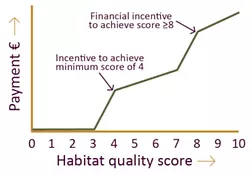
RBPS Approach
One of the key aims of LIFE IP Wild Atlantic Nature is to establish a voluntary pilot Results Based Payment Scheme (RBPS) linked to the quality of the habitat. This puts the landowner, their skills, expertise and knowledge of their land central to the development of this project. It creates a new market for the environmental services the landowner provides through their land management. In many cases, lands may already be delivering high quality environmental services. In other cases, landowners that wish to improve the environmental quality of their lands will be supported to achieve this. This provides an exciting opportunity for farmers in the project areas to realise and be celebrated for the vital role they play in our biodiversity and climate challenges. It also provides an opportunity to enhance the resilience of farming communities in and around Natura 2000 sites.
What is a Results-Based Payment Scheme?
Results-Based Payments Schemes link payments to the environmental quality of a farm, with higher nature quality resulting in a higher payment level. All participating land, both private and commonage, is divided into plots which each receive a habitat score annually of 0 to 10, depending on environmental quality. This score determines the payment levels. The quality of water courses and, in the case of private lands, farmyard management, influences the final payment via whole-farm assessment.

Results indicators
The management of farmland has a direct influence on the quality of habitat. Higher quality habitats deliver greater environmental services including biodiversity, water management and carbon storage. While Wild Atlantic Nature is primarily focused on conserving and restoring blanket bog habitat, the project also recognises the importance of associated habitats including woodland and grassland, and the need to consider the whole farm as part of an integrated approach toward sustainable land management. For this reason results indicators related to three key farm habitats – peatlands, woodlands, grasslands – are used in the evaluation process to determine a score for habitat quality assessment at the farm level.
Other features that determine the quality of habitat include farmyard management, nutrient balance, and condition and management of watercourses. These factors are considered in a whole-farm assessment, which determines the final results-based payment.
Assessment of results
Habitat quality assessment
Habitat quality is assessed at the field level using a scorecard specifically designed to evaluate key aspects of each habitat. The scorecard allocates marks to reflect the quality of the habitat in terms of specific indicators including biodiversity (plant species), water management, vegetation structure, exposed soil and damaging activities. The better the quality of the habitat, the higher the mark awarded in each section. Habitats receive a final score on a scale of 0 (low) to 10 (high) and the level of payments are linked with this score.
The Wild Atlantic Nature RBPS programme is a pilot, which aims to demonstrate the principles of the RBPS approach. Depending on project resources, it is hoped to be able to provide a habitat score for the entire farm within the programme area. This will provide the farmer with a clear indication of its performance in the future scenario that all of their lands are included.

Floodplain quality
Lands that flood are important for maintaining good quality habitat and water management. A functioning floodplain has the effect of slowing the rate and reducing the volume of flow. This is best achieved where high quality habitats occupy the floodplain. The provision of high quality floodplains along main rivers will therefore be rewarded through the pilot.
Whole-farm (or commonage) assessment
Each farm (or parcel in the case of commonage) is subject to a whole-farm assessment (or commonage unit assessment) of environmental quality and risks. This result is used to determine the final results-based payment to the farmer. Three assessments are considered:
Farmyard management identifies any risks related to environmental issues such as inadequate storage facilities, leaking oil tanks and inappropriate facilities.
Farm nutrient balance assesses the volume of slurry generated in relation to the availability of suitable spread lands.
Watercourse condition assesses all watercourses in relation to risks arising from flow, livestock, sediment and nutrients.
Each of the three assessments are allocated a score ranging from 0.3 (poor) to 1.2 (excellent). The result of the whole-farm assessment is the lowest score (0.3, 0.6, 1 or 1.2) achieved in any individual category. The final habitat quality score is multiplied by the whole-farm assessment result to determine the results-based payment each farmer will receive.
